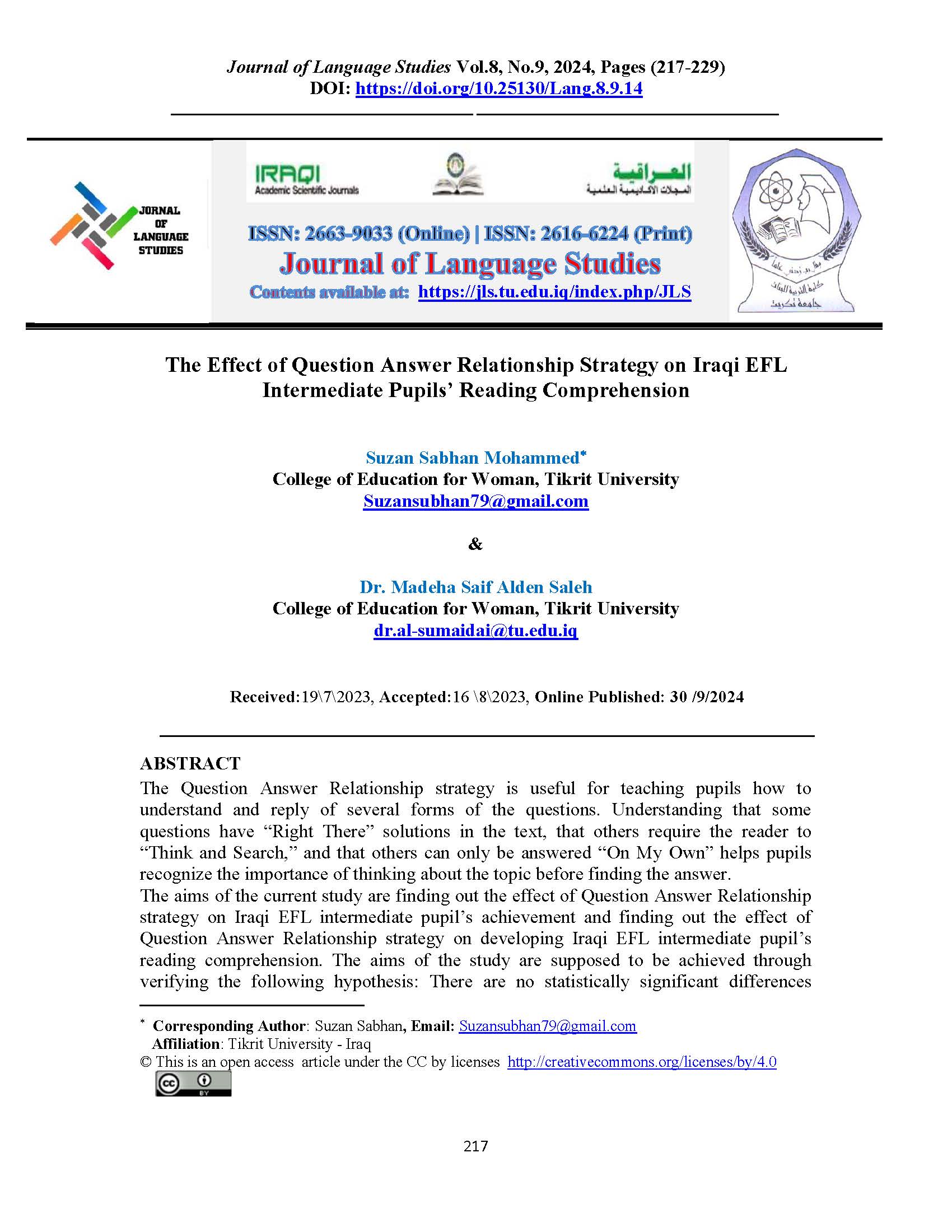The Effect of Question Answer Relationship Strategy on Iraqi EFL Intermediate Pupils’ Reading Comprehension
DOI:
https://doi.org/10.25130/Lang.8.9.14Keywords:
the effect, Questions Answer Relationship strategy, Iraqi EFL Intermediate School pupils, Reading ComprehensionAbstract
The Question Answer Relationship strategy is useful for teaching pupils how to understand and reply of several forms of the questions. Understanding that some questions have “Right There” solutions in the text, that others require the reader to “Think and Search,” and that others can only be answered “On My Own” helps pupils recognize the importance of thinking about the topic before finding the answer.
The aims of the current study are finding out the effect of Question Answer Relationship strategy on Iraqi EFL intermediate pupil’s achievement and finding out the effect of Question Answer Relationship strategy on developing Iraqi EFL intermediate pupil’s reading comprehension. The aims of the study are supposed to be achieved through verifying the following hypothesis: There are no statistically significant differences between the mean scores of the experimental group which is taught by question answer relationship strategy and the control group who is taught by prescribed method in pupil’s post achievement test . The second hypothesis states that there is no statistical significant differences between the mean scores of the experimental group in pre and post reading comprehension test. The sample of the current study consists of (60) pupils from the second grade at Karam AL Rahman Intermediate School for Boys is chosen at random to be the sample of the study. The sample is split into two groups: one for the experiment and the other is for the control. Both groups are similar in terms of their age, parent’s educational level and previous year’s English language scores. The experiment lasted for ten weeks ,the researcher taught the two groups during the academic year 2022-2023. To analyze the obtained data, different statistical means have been used T-test, Weighted mean to measure the pupils’ achievement. After the statistically treatment of the data.
References
Best, J. and Khan, J. (2006) Research in Education UK: Pearson Education Inc.
Cresswell, J. W. (2012). Educational Research. (4thed), Planning, conducting, And evaluating quantitative and qualitative research. Pearson Education: Boston.
Easterling, R. (2015). Fundamentals of Statistical Experimental Design and Analysis. Boston: John Wiley and Sons.
Falk, Beverly (1994). Teaching The Way Children Learn.Colombia: Colombia University Press.
Harmer, J.,(2001). The Practice of English Language Teaching,3rd edition. England: London.
Lapp, Diane (2004). Teaching All the Children: Strategies for Developing Literacy in an Urban Setting. New Your: The Guilford Press.
Lehman, Irvin & Mehrens, William, A.(1971). Educational Research
Lehr, F., Osborn, J., and Hiebert E. H. (2005). A Focus on Comprehension. Honolulu, Hawaii: Pacific Resources for Education and Learning.
Mart, C.T. (2015). ‘’Combining Extensive and Intensive Reading to Reinforce Language Learning ‘’. Journal Of Educational And Instructional studies In The World,5(4).
Milan,K., D.(1987). Developing Reading skills,2nd edition. New York: McGraw -Hill.
Nunan, D.(2003). Practical English Language Teaching,1st edition Singapore: McGraw -Hill Contemporary.
Patric , H (1971) Encyclopedia World Dictionary. London: The Hamlyn Publishing group LTD.
Pearson, D. E, & Johnson, D. D. (1978). Teaching reading comprehension: New York:Holt, Rinehart and Winston.
Pretorius, E., and Naude, H.(2002). ‘’A Culture in Transition: Poor Reading and Writing Ability Among Children in South Africa Townships ‘’.Early Child Development and Care,172.
Raphael, T. 1982. Improving Question-Answering Performance through Instruction. Reading Education Report No. 32. University of Illinois at Urbana-Champaign: Center for the Study of Reading.
Raphael, T. E., & Au, K. H. (2005). QAR: Enhancing comprehension and test taking Across grades and content areas. The Reading Teaching, 59(3), 206-221.
Raphael, T.E. (1986). Teaching Question Answer Relationship, Revisited. The Reading Teacher, 39(6), 516-522
Riazi, M, A. (2015). The Routledge Encyclopedia of Research Methods in Applied Linguistics. Basingstoke: Taylor and Francis Ltd.

